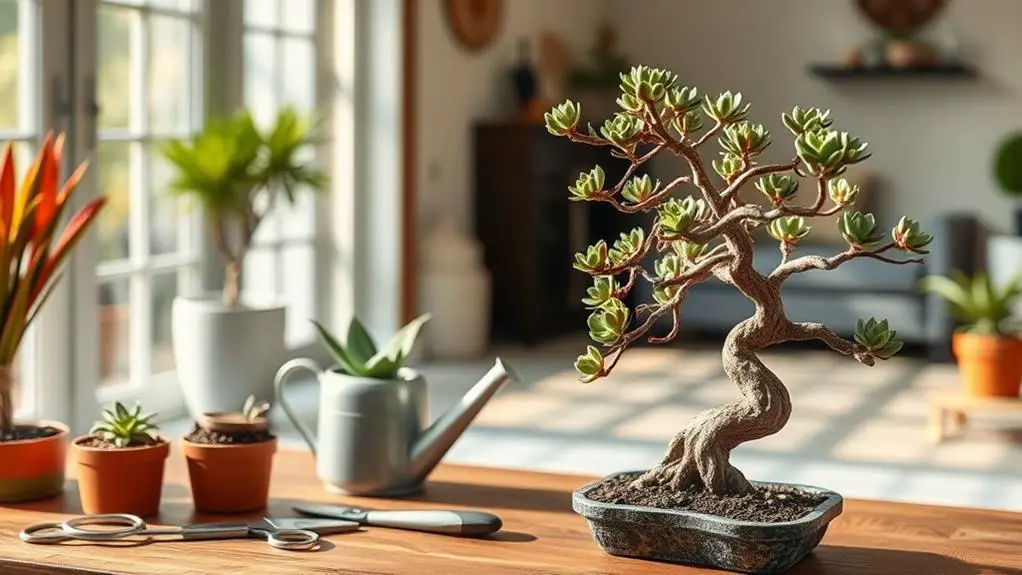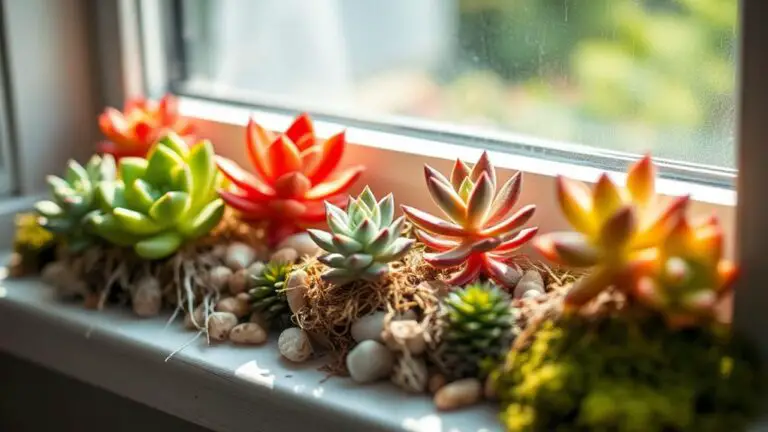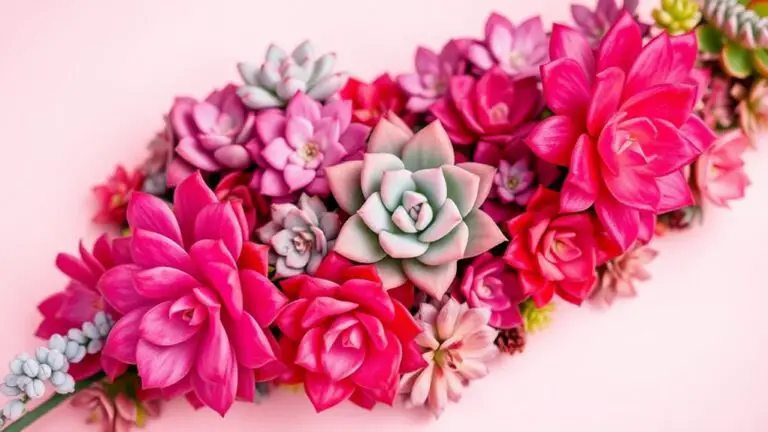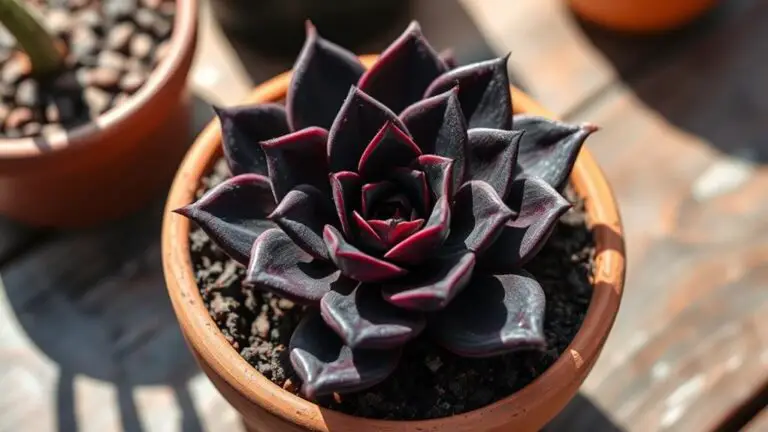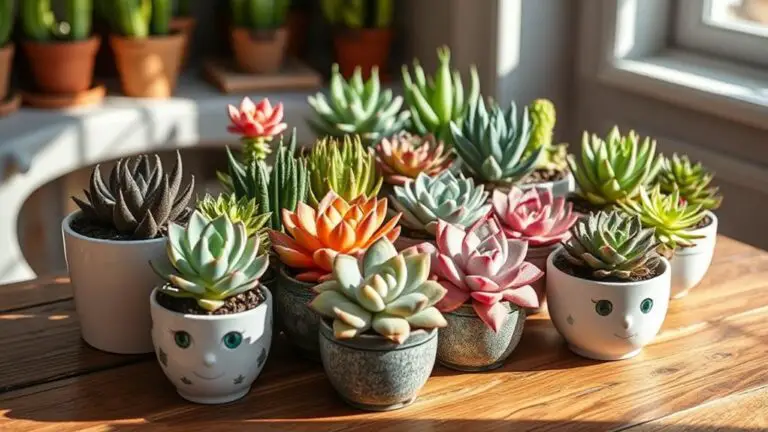10 Steps to Grow Succulents as Bonsais
When you decide to grow succulents as bonsais, you'll find it's a rewarding yet detailed process. Start by choosing the right succulent that suits your climate and can adapt to bonsai techniques. Selecting a shallow, well-draining pot and using specialized soil are critical next steps. But that's just the beginning. How do you guarantee your succulent gets the right amount of sunlight and water, or what methods help shape and maintain its miniaturized form? Let's explore these steps to transform your succulents into beautiful bonsai masterpieces.
Choose the Right Succulent

Choosing the right succulent is the first and most vital step in growing succulents as bonsais. When selecting succulent plants, it's important to pick healthy, well-established ones. Great choices include Crassula Ovata Obliqua (Jade Plant), Sedum varieties, and Aeoniums. These types have compact growth and appealing aesthetics, making them perfect for bonsai.
Look for succulents with smaller leaves and tighter branch spacing. These features enhance the overall appearance and make a bonsai look more realistic.
Research the natural growth habits of potential bonsai succulents. This helps you guarantee they match your desired bonsai style and that their care conditions align with what you can provide.
Consider the age and existing structure of the succulent. Younger plants are easier to shape into bonsai forms, while older ones might need more pruning and training.
Also, make certain the succulent can thrive in your climate. Some plants can't tolerate temperatures below 40°F (5°C) and might need indoor care.
Select a Suitable Pot

When selecting a pot for your succulent bonsai, it's key to choose a shallow, well-draining pot to keep water from sitting around the roots.
Make sure the pot has drainage holes so excess water can escape, helping your plant stay healthy.
For a nice touch, place some rocks or gravel at the bottom before adding soil to enhance drainage and give your succulent the best start.
Optimal Pot Size
Curious about the best pot size for your succulent bonsai? Choosing the right pot is essential for your plant's health and growth. The ideal pot size guarantees your succulent has enough space to grow without being too roomy, which can cause issues with moisture management.
Aim for a pot with a diameter that's 1 to 2 inches larger than the current root ball of your succulent. This provides a snug fit, giving roots room to spread while still promoting well-draining soil conditions.
When selecting a pot, keep these points in mind:
- Shallow and Well-Draining: A shallow pot helps root development and prevents excess water retention.
- Proportionate Size: Verify the pot is proportionate to the succulent, allowing for adequate space without being too large.
- Material Matters: Opt for terracotta or ceramic pots for better breathability and moisture regulation.
- Drainage Holes: Confirm the pot has drainage holes to allow excess water to escape.
Drainage and Aeration
Often, the key to a thriving succulent bonsai lies in selecting a pot that guarantees excellent drainage and aeration. First, choose a pot with drainage holes. These holes prevent water accumulation, which can lead to root rot in succulents. Without proper drainage, your plant might suffer and eventually die.
Shallow containers are ideal. They promote proper aeration and prevent excess moisture retention in the soil. This way, your succulent's roots get the air they need to stay healthy.
Additionally, select pots made from porous materials like clay or terracotta. These materials enhance evaporation and improve airflow to the roots, guaranteeing a well-draining soil environment.
Incorporate a layer of rocks or gravel at the bottom of the pot. This layer helps facilitate drainage and maintain soil stability, keeping your succulent's roots from sitting in water.
Also, verify the pot's size allows for some root growth while keeping the plant manageable. Typically, a pot that's 1-2 inches larger than the root ball is perfect.
Prune for Structure

Pruning is essential for shaping succulent bonsai, helping you craft a refined structure and promoting healthy lower branch growth. By carefully trimming your succulent, you can guide its growth to achieve a balanced and natural appearance. Clean cuts are vital, so make sure to use specialized tools to avoid leaving nubs that can lead to unsightly growth patterns.
Start by pruning the lower branches first. This reveals the trunk structure, enhancing the overall visual appeal of your bonsai. Regularly assess which branches to keep or remove. Aim for a Y-shaped branching pattern, which is a hallmark of traditional bonsai aesthetics. This will help you maintain the desired height and structure.
To help you visualize the process, here are some key steps:
- Reveal the trunk: Trim lower branches to expose the trunk, giving your bonsai a strong foundation.
- Encourage Y-shaped branching: Focus on creating Y-shaped branches for a classic bonsai look.
- Balance and symmetry: Keep the plant's overall balance in mind as you prune, aiming for symmetry.
- Use clean cuts: Always make clean cuts with specialized tools to promote healthy growth.
Use Well-Draining Soil

After shaping your succulent bonsai through careful pruning, the next step is providing the right foundation for its roots. Using well-draining soil is vital for succulent species.
Start with a porous soil mix specifically designed for cacti and succulents. This type of soil usually contains coarse sand, perlite, and bark. These components help promote good drainage, which is fundamental for preventing root rot.
You should aim for a soil pH that's neutral, ideally around 6.0 to 7.0. This range guarantees that your succulent bonsai can absorb nutrients effectively.
Additionally, incorporating mycorrhizal fungi into the soil mix can enhance root health and improve water absorption. These fungi form a beneficial relationship with the plant roots, helping them thrive.
Avoid using regular potting soil, as it retains too much moisture. Excess moisture can lead to root rot, which is very harmful to succulent species.
Make sure your pot has adequate drainage holes at the bottom. These holes allow excess water to escape, preventing water from accumulating in the soil.
Water Sparingly

Watering your succulent bonsai sparingly is vital to its health and longevity. Succulents are adapted to thrive in dry conditions, so it's important to let the soil completely dry out between waterings. Overwatering can lead to root rot, which is a common issue with these plants.
To help you manage the water supply for your succulent bonsai, keep these tips in mind:
- Monitor the soil: Verify it's well-draining and dries out completely before you water again.
- Check the leaves: Plump leaves indicate adequate moisture, while wrinkled or shriveled ones suggest it needs water.
- Winter care: Reduce watering frequency to every three weeks during winter when the plant enters dormancy.
- Drainage: Use pots with adequate drainage holes to prevent waterlogged soil.
Provide Adequate Light
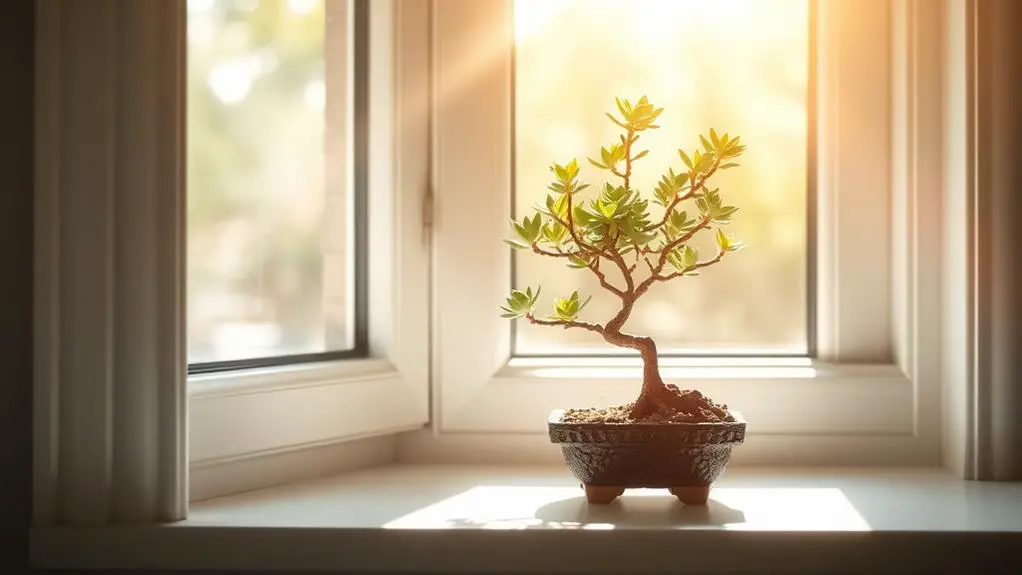
To keep your succulent bonsai healthy, make sure it gets plenty of bright, direct sunlight, aiming for about 6-8 hours daily.
Placing it near a south-facing window can help maximize light exposure.
If natural light is limited, especially in winter, consider using a full-spectrum grow light to prevent your plant from becoming weak or stretched out.
Optimal Sunlight Exposure
Bright light is essential for succulent bonsai, ensuring they get 6 to 8 hours of direct sunlight each day to maintain their health and vibrant colors.
Without proper sunlight exposure, your Succulent Bonsai trees can become elongated and lose their compact, attractive shape.
To provide the best light, place your bonsai near a south or west-facing window if you're growing them indoors. This positioning maximizes sunlight exposure and enhances growth potential.
To help you visualize:
- Bright sunlight: Think of a window bathed in warm, golden light for hours on end.
- South or west-facing: Picture the sun's rays streaming through these windows, casting long, bright shadows.
- Balanced structure: Imagine rotating your bonsai, ensuring each side gets its fair share of light.
- Winter support: Envision using grow lights, casting a gentle, steady glow during the darker months.
Preventing Light Deficiency
Assuring your succulent bonsai doesn't suffer from light deficiency is essential for maintaining its health and aesthetic appeal. Succulents as bonsai need bright sunlight to thrive, but they do best with bright, indirect light. Aim to give them at least 4-6 hours of light daily. This helps prevent etiolation, which is when plants stretch out and become leggy due to insufficient light.
Placing your bonsai near a south or west-facing window can provide the necessary light, especially from spring to autumn. If natural light is limited, don't worry! You can use grow lights with a full spectrum. Position these lights about 6-12 inches above your plants to mimic natural sunlight.
It's also important to rotate your bonsai every few weeks. This assures even light distribution and prevents uneven growth patterns.
Keep an eye out for signs of light deficiency, like stretched or leggy growth. These signs mean your plant is reaching for more light and needs better exposure.
Regular Pruning Techniques
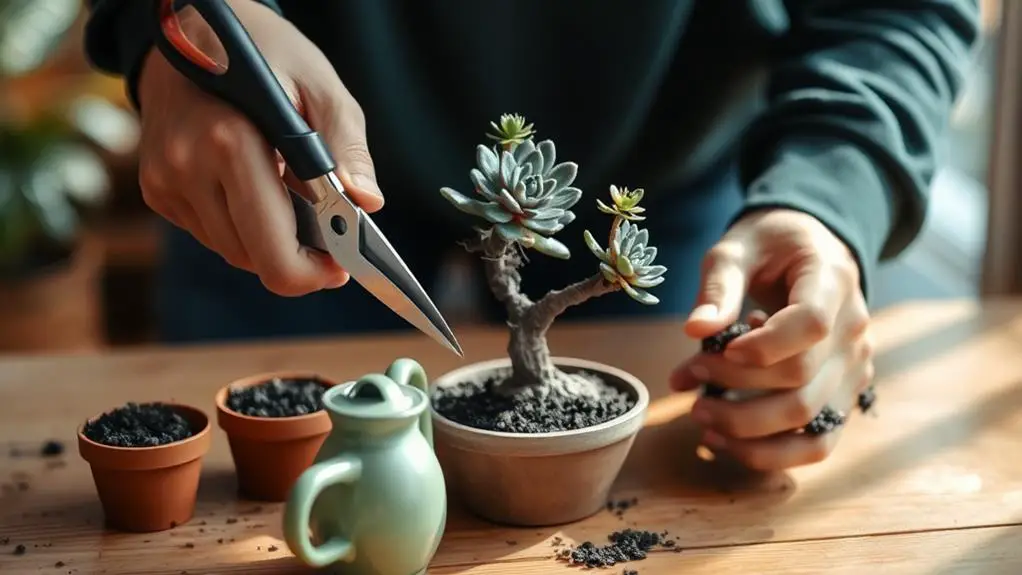
Regular pruning isn't just a maintenance task; it's an essential practice for shaping your succulent bonsai and promoting its health. By regularly pruning the leaves and branches, you can maintain the desired shape and size of your plant. This encourages lower branch growth and a bushier appearance, which is a hallmark of bonsai aesthetics.
To help you visualize your pruning tasks:
- Use clean, sharp tools: This guarantees precise cuts and prevents nubs that can lead to rot.
- Target the growing season: Pruning from spring to autumn allows for quicker recovery and regrowth.
- Aim for Y-shaped branching: This promotes the traditional bonsai look.
- Monitor closely: After pruning, keep an eye on your plant's health and adjust light and watering as needed.
When you prune, always think about the plant's health. Use clean, sharp tools to make precise cuts. This prevents damage and reduces the risk of rot.
Pruning during the growing season helps your plant recover faster. Aim to create Y-shaped branches, which are a key feature of bonsai.
After pruning, monitor your succulent closely to guarantee it's healthy and thriving. Adjust its care, like light and water, to support its recovery.
Wiring and Shaping
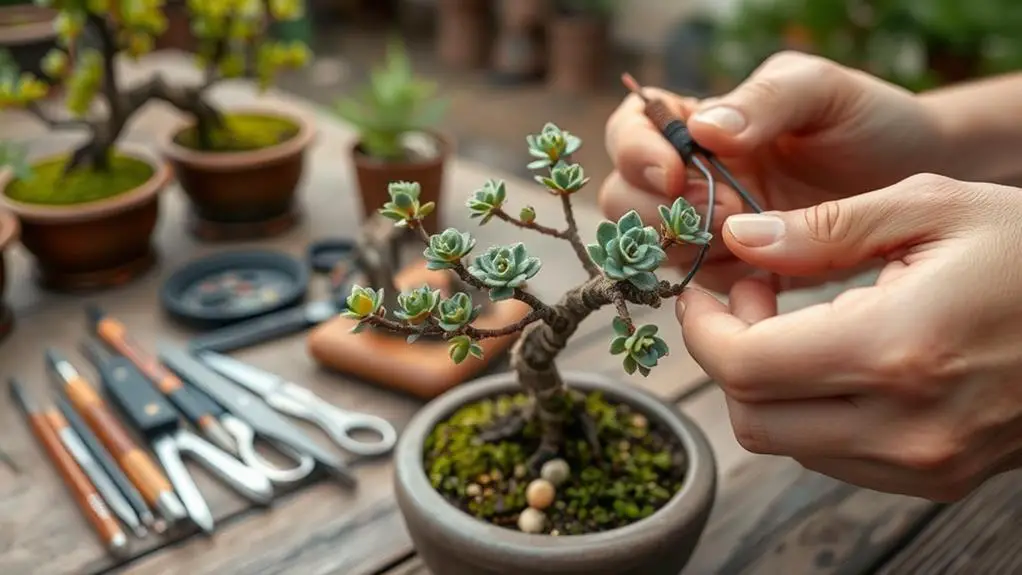
When wiring and shaping your succulent bonsai, start by choosing the right aluminum wire to guide your plant's growth.
Use effective shaping techniques, like wrapping the wire gently around branches to create beautiful curves and angles without causing harm.
Remember to manage plant stress by beginning with lower branches and checking the wire regularly to prevent damage.
Choosing Appropriate Wire
Selecting the right wire for wiring and shaping succulent bonsais is essential to their health and aesthetic. For Bonsai Succulents, choosing aluminum wire is a smart move. It's lightweight, flexible, and easy to manipulate without harming your plant.
When you're ready to start wiring, consider the following:
- Use a thicker wire (around 2-3 mm) for larger branches.
- Opt for thinner wire (1-2 mm) for delicate stems.
- Wrap the wire around the branch at a 45-degree angle.
- Confirm the wire is snug but not too tight.
Before you begin, make certain you use a well-draining soil to keep your succulent bonsais healthy. This helps prevent root rot, which can occur if the soil retains too much water.
When you start wiring, remember to stage the process by applying wire to one branch at a time. This minimizes stress and allows for gradual shaping, confirming that your plant isn't overwhelmed.
Regularly check the wire placement and adjust as needed. Remove the wire after a few months to avoid any long-term damage.
With patience and the right technique, you'll shape beautiful and healthy succulent bonsais.
Effective Shaping Techniques
To master effective shaping techniques for succulent bonsais, start by carefully applying aluminum wire around the branches. This lets you shape them into desired angles while minimizing stress on the plant.
Begin by wrapping the wire loosely around the branches. You can tighten it gradually to avoid damaging the stems. It's vital to blend aesthetics with the plant's natural growth habits. Avoid forcing shapes that conflict with the succulent's innate structure.
Regularly check the wiring to confirm it doesn't cut into the plant as it grows. Adjust or remove the wire when necessary to promote healthy development.
Combining wiring techniques with strategic pruning is also essential. Pruning helps encourage Y-shaped branching, which enhances the traditional bonsai appearance and promotes compact growth.
Using these effective shaping techniques, you'll be able to create beautiful bonsai forms without harming your succulents. Remember, patience and a gentle touch are key.
Managing Plant Stress
Managing plant stress during the wiring and shaping process is essential for the health and beauty of your succulent bonsai. When you use aluminum wire to shape branches, remember that succulents have delicate tissues. It's important to wrap the wire gently so you don't damage the plant.
Apply the wire in stages to avoid putting too much pressure on the branches all at once.
Pruning is another critical step. Prune your succulent bonsai regularly to maintain its shape and size, and to encourage Y-shaped branching. This helps the plant grow more compact and aesthetically pleasing.
Keep a close eye on your plant during this process, watching for signs of stress like wilting or discoloration. If you notice these signs, you might need to adjust your approach.
Here are some important tips to keep in mind:
- Wrap aluminum wire gently around branches.
- Prune regularly to maintain shape and encourage branching.
- Observe your plant closely for stress signs.
- Adjust the wire periodically as the plant grows.
Additionally, remember to water your succulent bonsai properly. Overwatering or underwatering can add stress, so find the right balance to keep your plant thriving.
Fertilize During Growth
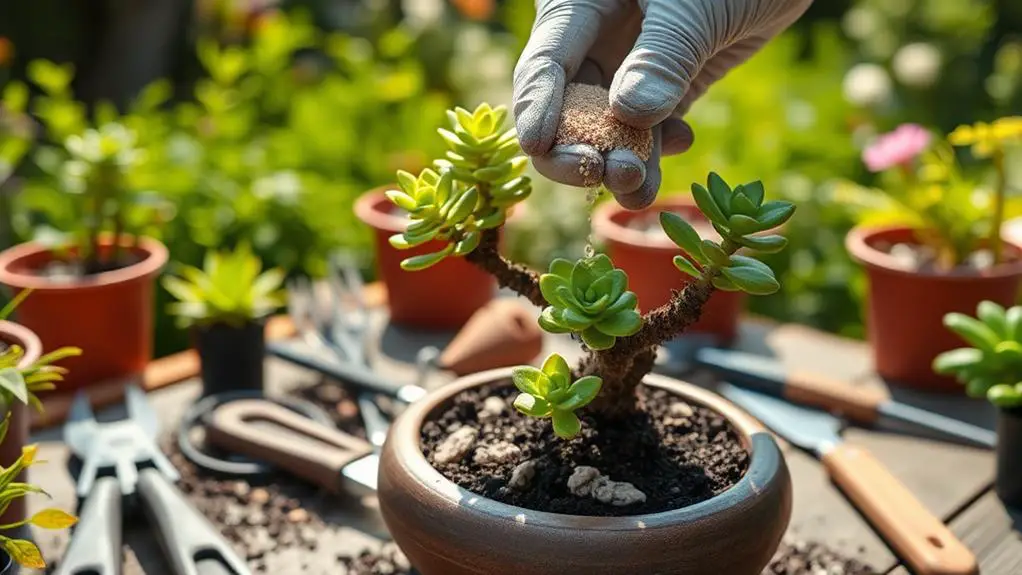
Fertilizing your succulent bonsai is essential for its healthy growth during the active season, which spans from spring to autumn. To begin, you should fertilize your succulent bonsai monthly. Use a balanced fertilizer, like 5-5-5 or 14-14-14, to provide the necessary nutrients for steady growth. Make certain to apply smaller, frequent doses to avoid over-fertilization, which can harm your plant and lead to excessive growth.
Always confirm the soil is moist when applying fertilizer. This helps prevent root burn and allows your succulent to absorb nutrients more effectively. Here's a quick guide to help you remember key points:
| Step | Action |
|---|---|
| 1 | Fertilize monthly during spring to autumn |
| 2 | Use a balanced 5-5-5 or 14-14-14 fertilizer |
| 3 | Apply small, frequent doses |
| 4 | Confirm soil is moist before fertilizing |
| 5 | Avoid fertilizing during winter dormancy |
Following these steps will help your succulent bonsai thrive. Remember, don't fertilize during the winter months as your plant requires fewer nutrients. By providing consistent and balanced nutrition, you'll support your succulent bonsai's growth and enjoy its beauty all year round.
Monitor for Pests
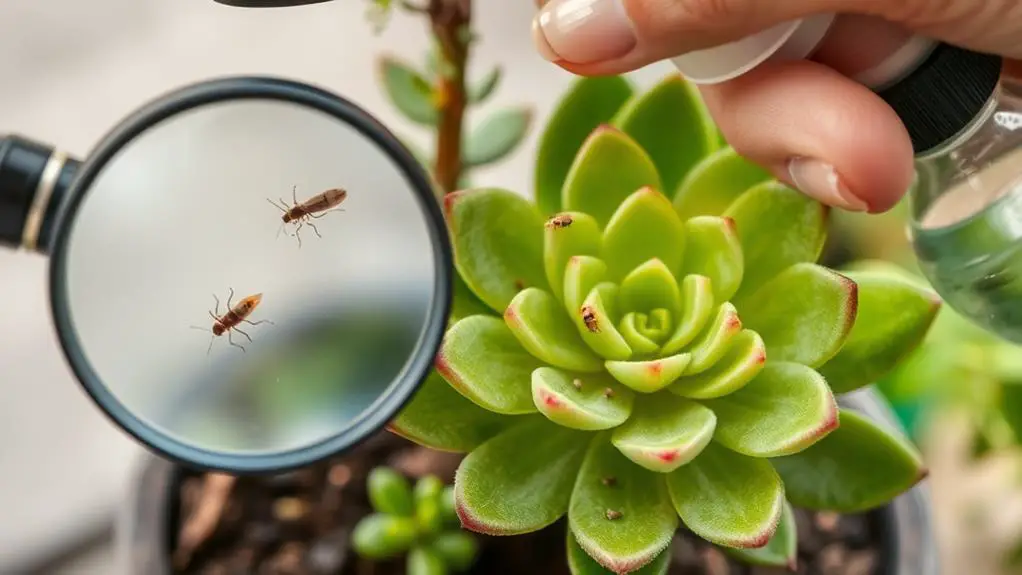
Keeping an eye out for pests is vital to maintaining a healthy succulent bonsai. Regularly inspecting your plant will help you spot common pests like spider mites, mealybugs, and whiteflies before they cause significant damage. These insects can weaken your succulent if not managed properly, so it's important to stay vigilant.
Good air circulation around your succulent bonsai is a key part of tree care. Proper airflow helps prevent pest infestations and keeps your plant thriving. Additionally, quarantine any new plants before adding them to your collection. This simple step guarantees you don't accidentally introduce pests to your healthy succulents.
Here are some practical tips to help you monitor for pests:
- Inspect your plant regularly, especially under leaves and around the soil.
- Guarantee good air circulation by placing your bonsai in a well-ventilated area.
- Quarantine new plants for a few weeks to check for hidden pests.
- Periodically spray the leaves with water to deter pests, as many are sensitive to moisture.
If you find pests, act quickly. Use insecticidal soap or horticultural oil to handle the infestation. By staying proactive, you'll keep your succulent bonsai healthy and beautiful.
Frequently Asked Questions
How to Turn a Succulent Into a Bonsai?
Select a healthy succulent with good trunk and branch characteristics. Prune lower branches, shape with wire, and repot in a shallow, well-draining container. Maintain its shape through strategic pruning and guarantee proper sunlight and watering.
How Do You Grow a Bonsai Tree Step by Step?
To grow a bonsai tree, start with a healthy sapling. Choose a suitable pot with good drainage, prune and shape the branches, and wire them gently. Water sparingly and make certain it gets adequate sunlight for ideal growth.
What Is the Difference Between a Bonsai Tree and a Succulent?
You'll find bonsai trees are traditional miniatures of regular trees, requiring detailed care and shaping. Succulents, on the other hand, store water in their leaves, making them low-maintenance and perfect for those with busy lives.
Does Succulent Soil Work for Bonsai?
Yes, succulent soil works for bonsai. It drains well, preventing root rot in water-storing plants. Use a mix of cinder, coarse aggregate, and organic material for proper aeration. Avoid regular potting soil; it retains too much moisture.
Conclusion
You've got this! Growing succulents as bonsais might seem tricky at first, but with the right steps, you'll succeed. Remember to pick healthy plants, use well-draining soil, and give them plenty of sunlight. Don't forget to prune regularly and watch for pests. By following these tips, you'll create beautiful bonsai succulents that thrive. So, plunge in with confidence and enjoy the rewarding journey of bonsai gardening. Happy growing!

